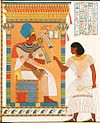Viceroy of Kush
| Viceroy of Kush in hieroglyphs | ||||||||
|---|---|---|---|---|---|---|---|---|
Sa-nisut-n-Kush Sꜣ-nswt-n-Kꜣš King's Son of Kush | ||||||||
The former Kingdom of Kerma in Nubia, was a province of ancient Egypt from the 16th century BCE to 11th century BCE. During this period, the region was ruled by a viceroy who reported directly to the Egyptian Pharaoh.
Initially the position was titled “King’s Son of the Southern Countries” and “King’s Son, Overseer of the Southern Foreign Countries” but by the reign of Thutmose IV the title “King’s Son of Kush” appears and becomes standard.[1]
The viceroy was responsible for overseeing the area north of the Third Cataract, which was divided into Wawat in the north, centered at Aniba, and Kush in the south, centered at Soleb during the Eighteenth Dynasty of Egypt and later at Amara West. They were supported in this task by two deputies, a number of scribes, an overseer of cattle, and the priests of local Egyptian built temples.[1][2]
Paintings in the tomb of Amenhotep Huy in the Theban necropolis depict some of the activities of a viceroy including overseeing the collection and tallying of tribute, and the delivery of said tribute by boat to the pharaoh in Thebes.[3][1]
The title eventually lapsed under Piankh, who led an unsuccessful campaign against his rebellious predecessor Pinehesy. After this point the title is attested only in a few tomb inscriptions outside of Nubia such as one of the wives of Pinedjem II who was named 'Superintendent of Southern Foreign Lands and Viceroy Kush' for unclear reasons.[1][4]
List of Viceroys
[edit]Below is a list of viceroys mainly based on a list assembled by George Reisner.
See also
[edit]References
[edit]- ^ a b c d Valbelle, Dominique (2020). "Egyptian Conquest and Administration of Nubia". In Emberling, Geoff; Williams, Bruce (eds.). The Oxford handbook of Ancient Nubia. New York: Oxford University Press. ISBN 978-0-19-049627-2.
- ^ Edwards, David N. (2004). "Lower Nubia in the New Kingdom". The Nubian Past. Routledge. ISBN 978-0415369886.
- ^ "The tomb of Huy, viceroy of Nubia in the reign of Tutʻankhamūn (no. 40) copied in line and colour by Nina de Garis Davies and with explanatory text by Alan H. ... v.4". HathiTrust. Retrieved 2024-11-26.
- ^ Edwards, David (2004). The Nubian Past. Oxon: Routledge. pp. 106, 117. ISBN 9780415369886.
- ^ Edwards, The Cambridge ancient history, Volumes 1-3, 2000, pg 299 and 348
- ^ The Viceroys of Ethiopia (Continued) by George A. Reisner, The Journal of Egyptian Archaeology, vol. 6, No. 2. (Apr., 1920), pp. 73-88.
- ^ a b c Kitchen, K.A., Ramesside Inscriptions, Translated & Annotated, Translations, Volume III, Blackwell Publishers, 1996
- ^ Dodson, Poisoned Legacy: The Fall of the Nineteenth Egyptian Dynasty, American University in Cairo Press, 2010
- ^ P. Pamminger, Göttinger Miszellen 137 (1993), 79-86
- ^ Briant Bohleke, An Ex Voto of the Previously Unrecognized Viceroy Setmose, Göttinger Miszellen 85 (1985), 13-24
- ^ a b Gerard P.F. Broekman, The Leading Theban Priests of Amun and their Families under Libyan Rule, The Journal of Egyptian Archaeology, Vol. 96 (2010), pp. 125-148
Further reading
[edit]- George A. Reisner, The Viceroys of Ethiopia, The Journal of Egyptian Archaeology, Vol. 6, No. 1 (Jan., 1920), pp. 28–55.
- George A. Reisner, The Viceroys of Ethiopia (Continued), The Journal of Egyptian Archaeology, Vol. 6, No. 2 (Apr., 1920), pp. 73–88.


